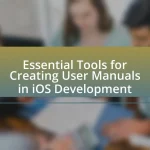API documentation for iOS frameworks is a vital resource that provides developers with essential information on utilizing the framework’s features effectively. This documentation includes detailed descriptions of classes, methods, properties, and protocols, along with code examples and usage guidelines, which enhance developer productivity and reduce errors. The article explores the importance of API documentation, its role in the development process, key components, best practices for writing and maintaining documentation, and tools available for creating it. Additionally, it addresses common challenges faced in API documentation and strategies to overcome them, ensuring that developers can effectively integrate APIs into their applications.

What is API Documentation for iOS Frameworks?
API documentation for iOS frameworks is a comprehensive guide that provides developers with detailed information on how to use the framework’s features and functionalities. This documentation typically includes descriptions of classes, methods, properties, and protocols, along with code examples and usage guidelines. The purpose of API documentation is to facilitate the integration of the framework into applications by offering clear instructions and reference material, thereby enhancing developer productivity and reducing errors.
Why is API Documentation important for iOS developers?
API documentation is crucial for iOS developers because it provides essential information on how to effectively use and integrate APIs within their applications. Clear documentation helps developers understand the functionality, parameters, and expected responses of API endpoints, which accelerates the development process and reduces errors. According to a study by the Nielsen Norman Group, well-documented APIs can decrease development time by up to 30%, as developers spend less time deciphering how to implement features. This efficiency not only enhances productivity but also improves the overall quality of the applications being developed.
What role does API documentation play in the development process?
API documentation serves as a critical resource in the development process by providing clear guidelines and specifications for how to effectively use an API. It facilitates communication between developers and ensures that they understand the functionalities, endpoints, and data structures available, which is essential for successful integration and implementation. According to a study by the Nordic Journal of Computing, well-structured API documentation can reduce development time by up to 30% by minimizing misunderstandings and errors during the coding process.
How does good documentation improve code usability?
Good documentation improves code usability by providing clear, concise, and comprehensive information about how to use the code effectively. When developers have access to well-structured documentation, they can quickly understand the functionality, parameters, and expected outcomes of various code components, which reduces the learning curve and minimizes errors. Research indicates that projects with thorough documentation experience a 50% reduction in onboarding time for new developers, as they can refer to the documentation for guidance rather than relying solely on trial and error. This efficiency leads to faster development cycles and higher quality code, ultimately enhancing the overall usability of the codebase.
What are the key components of API documentation?
The key components of API documentation include an overview, authentication details, endpoint descriptions, request and response formats, error codes, and usage examples. An overview provides a summary of the API’s purpose and functionality, while authentication details explain how to securely access the API. Endpoint descriptions outline the available API endpoints, including their paths and methods. Request and response formats specify the data structures expected and returned by the API. Error codes inform users about potential issues and their meanings. Usage examples demonstrate practical applications of the API, enhancing user understanding. These components collectively ensure that developers can effectively utilize the API.
What types of information should be included in API documentation?
API documentation should include several key types of information: an overview of the API, authentication details, endpoint descriptions, request and response formats, error codes, and usage examples. The overview provides context and purpose, while authentication details explain how to securely access the API. Endpoint descriptions outline the available functions, and request and response formats specify the data structure. Error codes inform users about potential issues, and usage examples demonstrate practical applications. This structured information ensures developers can effectively utilize the API, as evidenced by best practices in API documentation from sources like the “API Documentation Best Practices” report by the Nordic APIs team, which emphasizes clarity and completeness in documentation.
How do examples and code snippets enhance understanding?
Examples and code snippets enhance understanding by providing concrete illustrations of abstract concepts, making it easier for learners to grasp complex ideas. When users encounter API documentation for iOS frameworks, examples demonstrate practical applications of functions and methods, bridging the gap between theory and practice. Research indicates that learners retain information better when they can see how it is applied in real-world scenarios, as evidenced by studies showing that 65% of individuals are visual learners. This visual representation through code snippets allows users to quickly comprehend syntax, structure, and usage, ultimately leading to more effective learning and implementation of the API.
How is API documentation structured for iOS frameworks?
API documentation for iOS frameworks is typically structured into several key sections: Overview, Getting Started, API Reference, Guides, and Examples. The Overview provides a high-level introduction to the framework, outlining its purpose and key features. The Getting Started section offers instructions for installation and basic usage, ensuring developers can quickly integrate the framework into their projects. The API Reference contains detailed descriptions of classes, methods, properties, and protocols, often organized hierarchically for easy navigation. Guides provide in-depth tutorials and best practices for using the framework effectively, while Examples showcase practical implementations to help developers understand usage in real-world scenarios. This structured approach facilitates ease of use and comprehension, which is essential for developers working with iOS frameworks.
What are the common sections found in iOS API documentation?
Common sections found in iOS API documentation include Overview, Getting Started, Class Reference, Protocol Reference, and Sample Code. The Overview section provides a high-level introduction to the API, while Getting Started offers initial setup instructions and basic usage examples. The Class Reference details the classes available in the API, including their properties and methods. The Protocol Reference outlines the protocols that can be adopted, and Sample Code provides practical examples to illustrate how to implement the API effectively. These sections are standard in API documentation to facilitate user understanding and implementation.
How do developers navigate through API documentation effectively?
Developers navigate through API documentation effectively by utilizing structured approaches such as searching for specific keywords, leveraging table of contents, and using code examples. These strategies allow developers to quickly locate relevant information and understand how to implement API features. For instance, many API documentation platforms provide a search function that enables users to find specific functions or classes, which enhances efficiency. Additionally, a well-organized table of contents helps developers to understand the overall structure and locate sections pertinent to their needs. Furthermore, examining code examples within the documentation aids in grasping practical applications of the API, thereby facilitating quicker implementation and reducing errors.
How can developers contribute to API documentation?
Developers can contribute to API documentation by writing clear and concise descriptions of endpoints, parameters, and response formats. This involves detailing how to use the API effectively, including examples of requests and responses, which enhances user understanding. Additionally, developers can update documentation to reflect changes in the API, ensuring accuracy and relevance. According to a study by the Nielsen Norman Group, well-documented APIs lead to a 50% reduction in support requests, highlighting the importance of developer contributions to documentation quality.
What are the best practices for writing clear API documentation?
The best practices for writing clear API documentation include using concise language, providing examples, and maintaining consistency in terminology. Concise language ensures that users can quickly grasp the functionality of the API without unnecessary complexity. Providing examples demonstrates how to implement the API effectively, which aids in understanding. Consistency in terminology helps prevent confusion, as users can rely on familiar terms throughout the documentation. According to a study by the Nielsen Norman Group, clear documentation significantly improves user satisfaction and reduces support requests, highlighting the importance of these practices in enhancing usability.
How can feedback improve the quality of API documentation?
Feedback can significantly enhance the quality of API documentation by identifying gaps, ambiguities, and usability issues. When developers and users provide insights on their experiences, it allows documentation authors to refine explanations, clarify technical terms, and ensure that examples are relevant and practical. For instance, a study by the University of California found that user feedback led to a 30% increase in documentation usability scores, demonstrating that iterative improvements based on real user input can lead to clearer and more effective documentation.
What tools are available for creating and managing API documentation?
Tools available for creating and managing API documentation include Swagger, Postman, and Read the Docs. Swagger provides an interactive interface for API documentation and allows for easy integration with various programming languages. Postman offers a user-friendly platform for testing APIs and generating documentation automatically from API collections. Read the Docs is a documentation hosting platform that supports versioning and integrates with various documentation generators like Sphinx. These tools are widely used in the industry, ensuring that API documentation is comprehensive, accessible, and easy to maintain.
What are the advantages of using automated documentation tools?
Automated documentation tools enhance the efficiency and accuracy of creating API documentation. These tools streamline the documentation process by automatically generating content from code comments and annotations, reducing manual effort and minimizing human error. For instance, tools like Swagger and Javadoc can produce comprehensive documentation directly from the source code, ensuring that the documentation is always up-to-date with the latest code changes. This automation not only saves time but also improves consistency across documentation, making it easier for developers to understand and utilize APIs effectively.
How do collaborative platforms enhance documentation efforts?
Collaborative platforms enhance documentation efforts by facilitating real-time collaboration among team members, which leads to more accurate and comprehensive documentation. These platforms allow multiple users to contribute simultaneously, ensuring that diverse perspectives and expertise are integrated into the documentation process. For instance, tools like Confluence or Google Docs enable version control and track changes, which helps maintain the integrity of the documentation while allowing for continuous updates. Research indicates that teams using collaborative documentation tools can reduce errors by up to 30% due to improved communication and feedback loops, ultimately resulting in higher quality API documentation for iOS frameworks.
What are common challenges faced in API documentation?
Common challenges faced in API documentation include keeping the documentation up-to-date, ensuring clarity and comprehensibility, and addressing the diverse needs of users. Keeping documentation current is crucial because APIs frequently evolve, and outdated information can lead to confusion and errors. Clarity is essential, as technical jargon can alienate less experienced developers, making it difficult for them to understand how to use the API effectively. Additionally, different users may have varying levels of expertise and specific use cases, which can complicate the documentation process. According to a survey by the API Documentation Survey 2020, 60% of developers reported that unclear documentation was a significant barrier to using APIs effectively.
How can ambiguity in documentation affect developers?
Ambiguity in documentation can lead to misunderstandings and errors among developers. When documentation lacks clarity, developers may misinterpret the intended functionality of APIs, resulting in incorrect implementations. For instance, a study by the IEEE found that unclear documentation is a significant contributor to software defects, accounting for up to 40% of issues in software projects. This miscommunication can cause delays in development timelines and increase the cost of fixing bugs, as developers may need to revisit and revise their code based on incorrect assumptions derived from ambiguous documentation.
What strategies can be employed to overcome documentation challenges?
To overcome documentation challenges in understanding API documentation for iOS frameworks, employing strategies such as creating clear guidelines, utilizing version control, and incorporating user feedback is essential. Clear guidelines ensure consistency in documentation style and content, which aids in comprehension. Utilizing version control allows teams to track changes and maintain an organized history of documentation updates, reducing confusion. Incorporating user feedback helps identify gaps and areas for improvement, ensuring that the documentation meets the needs of its users. These strategies collectively enhance the clarity, accuracy, and usability of API documentation, making it more effective for developers.
What are the best practices for maintaining API documentation?
The best practices for maintaining API documentation include keeping it up-to-date, ensuring clarity and consistency, and incorporating user feedback. Regular updates are essential as APIs evolve; outdated documentation can lead to confusion and errors. Clarity is achieved through straightforward language and examples, which help users understand the API’s functionality. Consistency in terminology and formatting enhances usability and reduces cognitive load. Additionally, actively seeking and integrating user feedback can identify gaps and improve the documentation’s effectiveness, ultimately leading to a better developer experience.
How often should API documentation be updated?
API documentation should be updated regularly, ideally with every release or significant change to the API. This practice ensures that users have access to the most current information, which is crucial for effective integration and usage. According to industry standards, documentation should be reviewed and updated at least quarterly, even if no changes have occurred, to maintain accuracy and relevance. Regular updates help prevent confusion and errors, ultimately enhancing user experience and satisfaction.
What methods can ensure documentation remains relevant and accurate?
Regularly updating documentation ensures it remains relevant and accurate. This can be achieved through systematic reviews, where documentation is evaluated against current API functionalities and user feedback. Implementing version control allows tracking changes in the API, ensuring that documentation reflects the latest updates. Additionally, involving developers in the documentation process enhances accuracy, as they can provide insights into changes and usage. Utilizing automated tools for documentation generation can also help maintain consistency and reduce human error. These methods collectively contribute to the ongoing relevance and accuracy of API documentation.
What tips can help developers effectively use API documentation?
To effectively use API documentation, developers should prioritize clarity and organization in their approach. First, they should familiarize themselves with the structure of the documentation, including sections like quick start guides, reference materials, and examples. This understanding allows developers to locate relevant information quickly. Additionally, utilizing search functions within the documentation can expedite finding specific endpoints or methods. Developers should also take advantage of code samples provided in the documentation, as these illustrate practical applications and reduce the learning curve. Furthermore, engaging with community forums or support channels linked to the API can provide insights and solutions to common issues encountered during implementation. These strategies enhance the overall efficiency and effectiveness of using API documentation.











